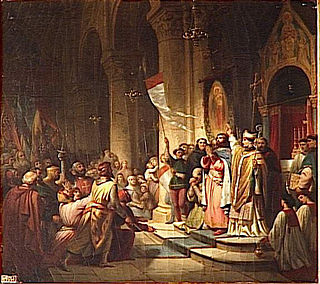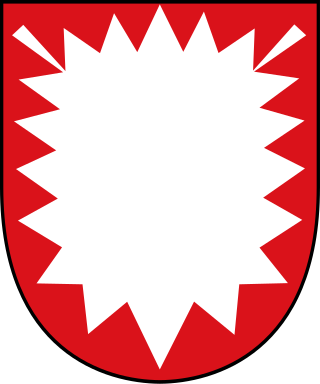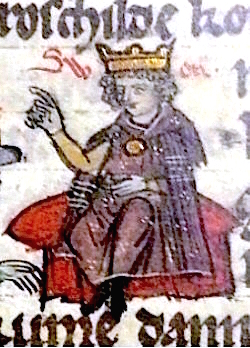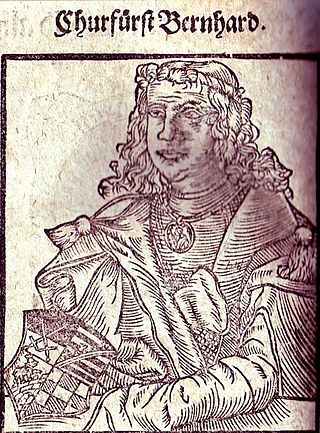History
After Adolf III of Holstein returned to Europe from the Third Crusade in 1197, a disagreement between him and the Danish King Canute VI broke out on the island of Rügen in 1200, followed by an armed conflict in Dithmarschen.
Duke Valdemar of Schleswig ordered his army to prepare for war and side with Denmark, ruled by his brother. Adolf led his German army from Holstein to battle in Stellau and crushed the Danes. However, when Adolf and his forces pulled back toward the city of Hamburg, he was besieged, defeated, and captured by Valdemar.
In 1202, Valdemar of Schleswig became King Valdemar II of Denmark. His imprisonment of Adolf continued until 1203, when due to an illness, he was freed by the new king on the condition that he waive all claims to Holstein. Adolf withdrew to his ancestral seat, Schaumburg Castle, where he remained until his death in 1225.
After this battle, Valdemar acquired the nicknamed "the Conqueror," and maintained his hegemony over the north German coast, including Holstein. His authority continued until the Battle of Bornhöved in 1227, where he was defeated by Adolf IV of Holstein, the son of Adolf III.
A Romanesque stone church consecrated in 1230 by Archbishop Gebhard II of Bremen now marks the historic battle site in Stellau.

Year 1201 (MCCI) was a common year starting on Monday of the Julian calendar.

Holstein is the region between the rivers Elbe and Eider. It is the southern half of Schleswig-Holstein, the northernmost state of Germany.

Valdemar II Valdemarsen, later remembered as Valdemar the Victorious and Valdemar the Conqueror, was King of Denmark from 1202 until his death in 1241.

Valdemar I Knudsen, also known as Valdemar the Great, was King of Denmark from 1154 until his death in 1182. The reign of King Valdemar I saw the rise of Denmark, which reached its medieval zenith under his son King Valdemar II.

The history of Schleswig-Holstein consists of the corpus of facts since the pre-history times until the modern establishing of the Schleswig-Holstein state.

Canute VI was King of Denmark from 1182 to 1202. Contemporary sources describe Canute as an earnest, strongly religious man.

Eric IV, also known as Eric Ploughpenny or Eric Plowpenny, was King of Denmark from 1241 until his death in 1250. His reign was marked by conflict and civil wars against his brothers.

Abel Valdemarsen was Duke of Schleswig from 1232 to 1252 and King of Denmark from 1250 until his death in 1252. He was the son of Valdemar II by his second wife, Berengaria of Portugal, and brother to kings Eric IV and Christopher I.

Sweyn III Grathe was the king of Denmark between 1146 and 1157, in shifting alliances with Canute V and his own cousin Valdemar I. In 1157, the three agreed to a tripartition of Denmark. Sweyn attempted to kill his rivals at the peace banquet, and was subsequently defeated by Valdemar I at the Battle of Grathe Heath and killed.
The Treaty of Ribe was a proclamation at Ribe made in 1460 by King Christian I of Denmark to a number of Holsatian nobles enabling himself to become Count of Holstein and gain control of the Duchy of Schleswig. The most famous line of the proclamation was that the Danish Duchy of Schleswig and the County of Holstein within the Holy Roman Empire, should now be, in the original Middle Low German language, Up Ewig Ungedeelt, or "Forever Undivided".

The (second) Battle of Bornhöved took place on 22 July 1227 near Bornhöved in Holstein. Count Adolf IV of Schauenburg and Holstein — leading an army consisting of troops from the cities of Lübeck and Hamburg, Dithmarschen, Holstein, and various Northern German nobles, defeated King Valdemar II of Denmark and the Welf Otto the Child.

The Counts of Schauenburg and Holstein were titles of the Holy Roman Empire. The dynastic family came from the County of Schauenburg near Rinteln on the Weser in Germany. Together with its ancestral possessions in Bückeburg and Stadthagen, the House of Schauenburg ruled the County of Schauenburg and the County of Holstein. The comital titles of Holstein were subject to the liege lord, the Dukes of undivided Saxony until 1296, and thereafter the Dukes of Saxe-Lauenburg.

Bernhard, a member of the House of Ascania, was Count of Anhalt and Ballenstedt, and Lord of Bernburg through his paternal inheritance. From 1180 he was also Duke of Saxony.
Valdemar Knudsen was a Danish clergyman and statesman. Valdemar was Bishop of Schleswig from 1188 to 1208, officiated as Steward of the Duchy of Schleswig between 1184 and 1187, and served as Prince-Archbishop of Bremen from 1192 to 1194 and again between 1206 and 1217. He held the latter office on the grounds of the archdiocesan capitular election as archbishop elect and of the royal investiture with the princely regalia, but lacked the papal confirmation.

Adolf III, Count of Schauenburg and Holstein was the ruler of the Counties of Schauenburg and Holstein. He is particularly remembered for his establishment of a new settlement for traders on the banks of the Alster near the Neue Burg in Hamburg.
Nicholas I was Bishop of Schleswig between 1209 and 1233. Since 1192 he de facto, though not consecrated, officiated during the flight and following royal captivity of his predecessor Bishop Valdemar (1193–1206).

The Danish Civil Wars were a series of civil wars fought in the Kingdom of Denmark, first from 1131 to 1134 over the murder of Canute Lavard, then from 1139 to 1143, and finally a war of succession fought from 1146 to 1157, after the abdication of Eric III of Denmark, the first monarch in Danish history to have abdicated. The first phase of the war was fought between King Eric II of Denmark and King Niels joined by Magnus the Strong. The second phase of the war was fought between the son of Magnus the Strong, Canute V of Denmark, the son of Eric II of Denmark, Sweyn III of Denmark, and his cousin Valdemar I of Denmark, son of Canute Lavard. The civil wars marked an increase in the influence of the Holy Roman Empire in Denmark, and for a time after, Denmark was a vassal state of Emperor Frederick I. The war ended with the deaths of seven kings. Two of the kings, Olaf Haraldsen and Magnus the Strong, are not amongst the official Danish line of kings. The other kings are Niels I, Eric II, Eric III, Canute V and Sweyn III.
Events from the 12th century in Denmark.
Events from the 13th century in Denmark.

The Valdemarian Age commonly also referred to as the Valdemars refers to an 84-year long period in Danish history between 1157 and 1241, beginning with the reign of Valdemar I, and ending with the death of Valdemar II. The period is heavily centered around the Danish Crusades in the Baltic Sea.














